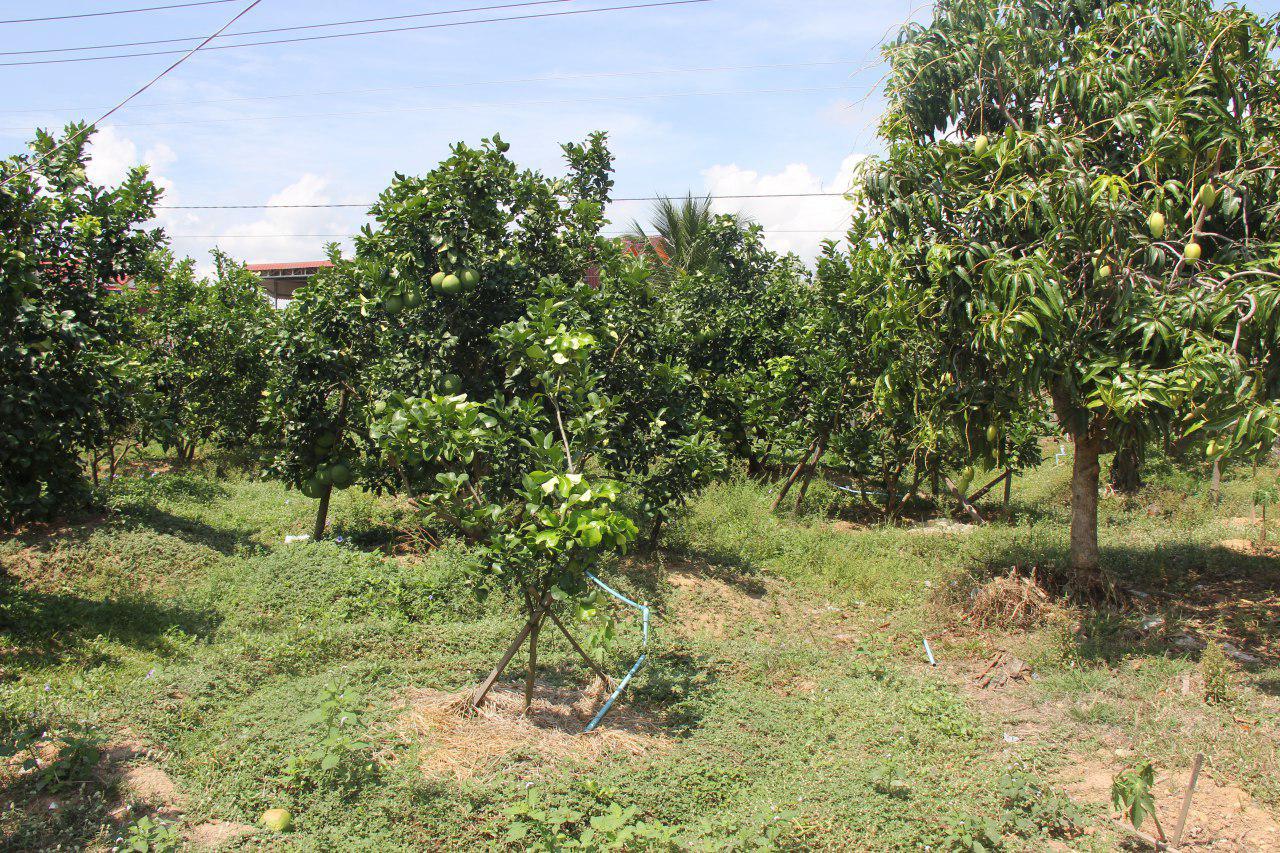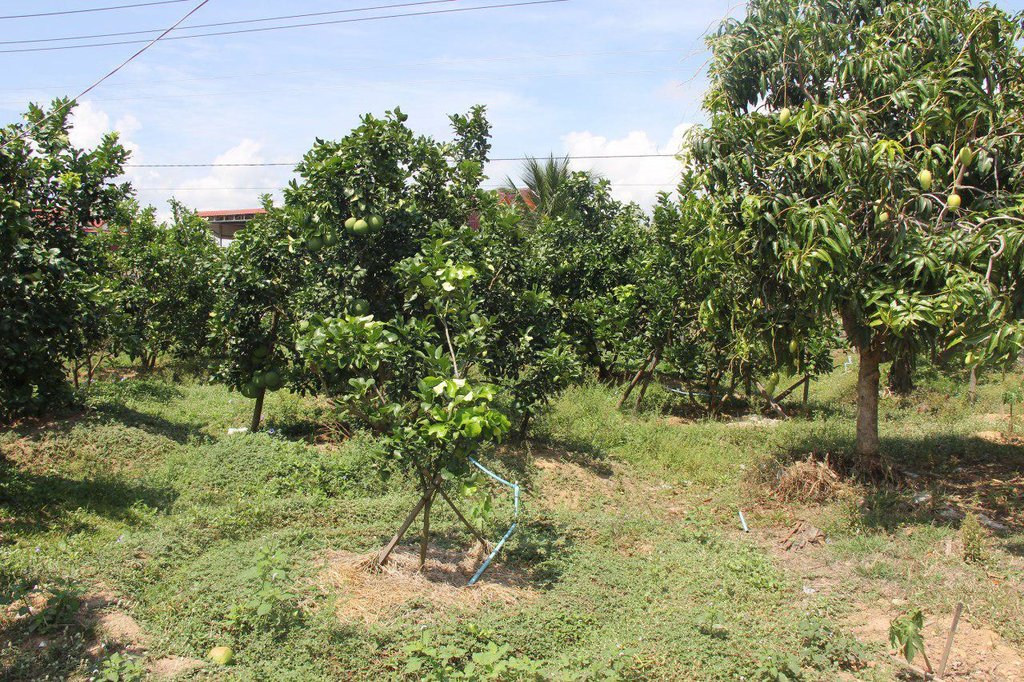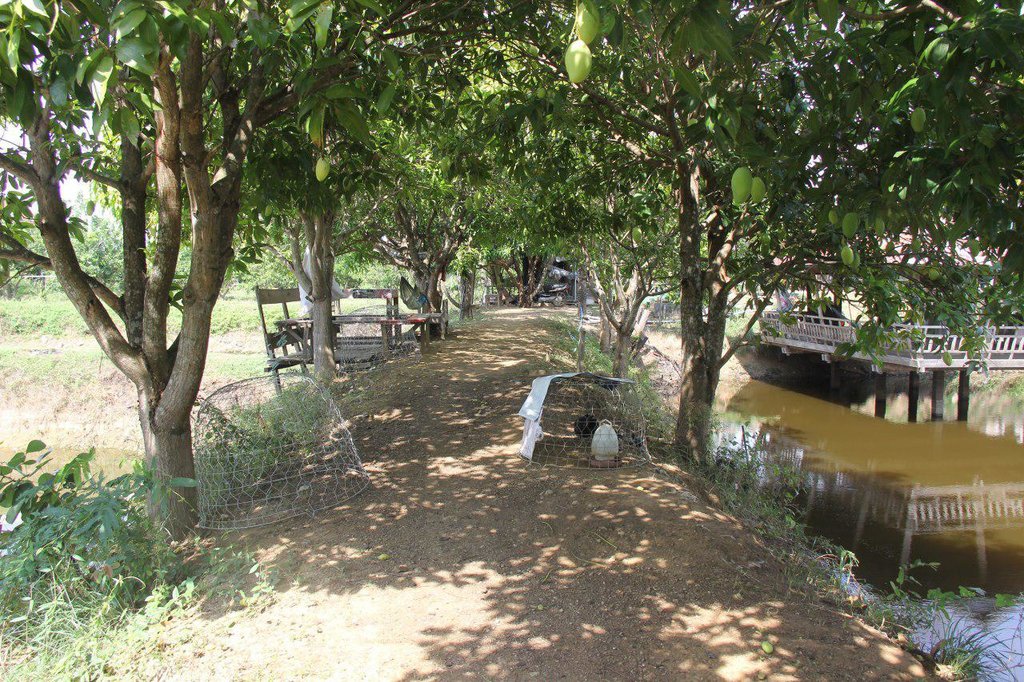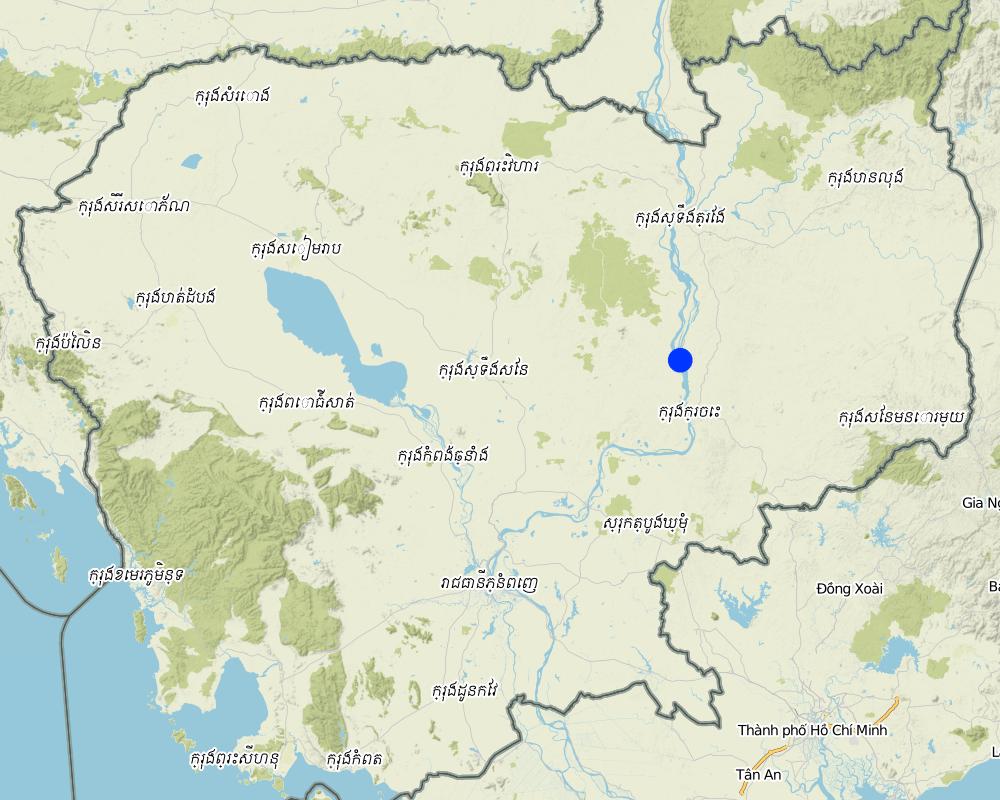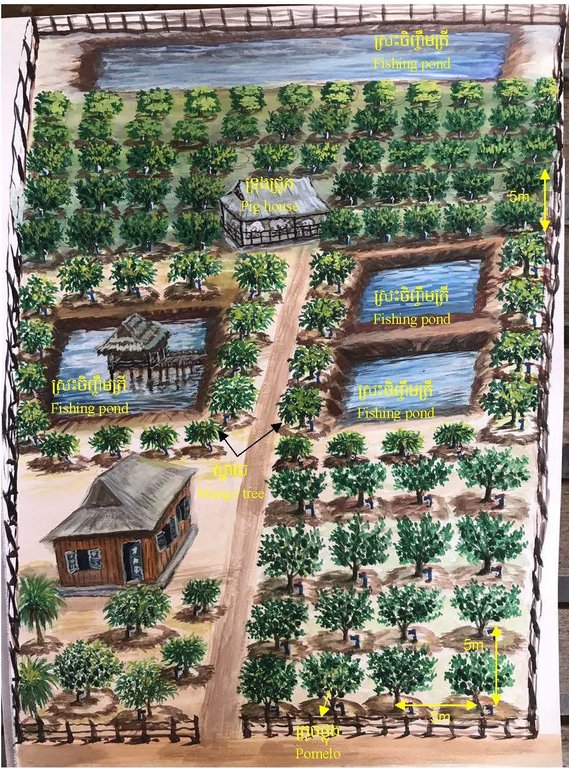ការបង្កើនផលិតកម្មដំណាំហូបផ្លែជាមួយប្រព័ន្ធកសិកម្មចម្រុះ [Cambodia]
- Creation:
- Update:
- Compiler: Sok Pheak
- Editors: Navin Chea, Sophea Tim
- Reviewers: Nimul CHUN, Nicole Harari, Stephanie Jaquet, Ursula Gaemperli
អូនចម្ការក្រូច
technologies_2263 - Cambodia
View sections
Expand all Collapse all1. General information
1.2 Contact details of resource persons and institutions involved in the assessment and documentation of the Technology
Key resource person(s)
land user:
ចេតនា គាត
(+855) 97 8810 707
មិនមានអ៊ីម៉ែល
អ្នកប្រើប្រាស់ដី
ភួមិកែងប្រាសាទ ឃុំសំបូរ ស្រុកសំបូរ ខេត្តក្រចេះ
Cambodia
ប្រធានការិយាល័យកសិកម្ម រុក្ខាប្រមាញ់ និងនេសាទស្រុកសំបូរ:
ប្រធានការិយាល័យទទួលបន្ទុករួមកសិកម្ម រុក្ខាប្រមាញ់ និងនេសាទស្រុកព្រែកប្រសព្វ:
មន្ត្រីការិយាល័យកសិកម្ម រុក្ខាប្រមាញ់ និងនេសាទស្រុកចិត្របុរី:
លី សារ៉ាវុធ
(+855) 89 796 786
saravuthyly123@gmail.com
ការិយាល័យកសិកម្ម រុក្ខាប្រមាញ់ និងនេសាទស្រុកចិត្របុរី
ភូមិខ្សារ ឃុំដារ ស្រុកចិត្របុរី ខេត្តក្រចេះ
Cambodia
Name of project which facilitated the documentation/ evaluation of the Technology (if relevant)
Scaling-up SLM practices by smallholder farmers (IFAD)Name of the institution(s) which facilitated the documentation/ evaluation of the Technology (if relevant)
Royal University of Agriculture (RUA) - Cambodia1.3 Conditions regarding the use of data documented through WOCAT
When were the data compiled (in the field)?
07/04/2017
The compiler and key resource person(s) accept the conditions regarding the use of data documented through WOCAT:
Ja
1.4 Declaration on sustainability of the described Technology
Is the Technology described here problematic with regard to land degradation, so that it cannot be declared a sustainable land management technology?
Nee
Comments:
ការអនុវត្តបច្ចេកទេសនេះផ្តោតទៅលើការប្រើប្រាស់ជីធម្មជាតិរួមមានលាមកជ្រូក គោ និងមាន់ ដែលជាជីសរីរាង្គ និងប្រើប្រាស់ប្រព័ន្ធដំណក់ទឹកដើម្បីកាត់បន្ថយការប្រើប្រាស់ទឹកលើដំណាំហូបផ្លែ។
2. Description of the SLM Technology
2.1 Short description of the Technology
Definition of the Technology:
ប្រព័ន្ធកសិកម្មចម្រុះគឺជាការធ្វើកសិកម្មច្រើនប្រភេទដែលមានដូចជា៖ផលិតកម្មដំណាំ ការចិញ្ចឹមសត្វ និងការចិញ្ចឹមត្រីនៅលើទីតាំងតែមួយ។ ការអនុវត្តប្រព័ន្ធកសិកម្មចម្រុះ បានជួយបង្កើនគុណភាពដី និងបង្កើនផលិតផលឈើហូបផ្លែយ៉ាងមានប្រសិទ្ធភាពដោយបានប្រើប្រាស់ធនធានក្នុងចម្ការឱ្យអស់លទ្ធភាពកាត់បន្ថយធាតុចូលកសិកម្មពីខាងក្រៅ។
2.2 Detailed description of the Technology
Description:
ប្រជាជនកម្ពុជានិយមដាំដំណាំឈើហូបផ្លែ និងគេតែងតែឃើញមានប្រភេទដំណាំដាំនៅលើដីគ្រប់ប្រភេទទូទាំងប្រទេស។ ប្រព័ន្ធកសិកម្មចម្រុះជាការធ្វើកសិកម្មនៅលើកសិដ្ឋានជាក់លាក់មួយដែលរួមមាន៖ ផលិតកម្មដំណាំ ការចិញ្ចឹមសត្វ (ជ្រូក មាន់) និងការចិញ្ចឹមត្រី។ គោលបំណងសំខាន់ ដើម្បីទ្រទ្រង់ និងបំពេញសេចក្តីត្រូវការរបស់កសិករ ទទួលផលចំណេញខ្ពស់ដោយមិនធ្វើឱ្យផ្លាស់ប្តូរលំនឹងអេកូឡូស៊ី។ ការរួមបញ្ចូលគ្នារវាងដំណាំ សត្វ និងត្រី គឺជាភាពចម្រុះ ដ៏ល្អហើយសាមញ្ញដែលប្រជាជនភាគច្រើនបានអនុវត្ត។ កសិករដែលជ្រើសរើសមកសិក្សា និង អនុវត្តបច្ចេកទេសនេះនៅលើដីដែលមានកម្រិតជីជាតិទាបជាប្រភេទដីប្រទះឡាង។ ដីប្រភេទនេះជាទូទៅពុំសូវសមស្រប សម្រាប់ដាំដំណាំនោះទេ រួមទាំងដំណាំហូបផ្លែផងដែរព្រោះវាផ្តល់នូវផលិតផលទាប។ គាត់បានដាំ ដំណាំឈើហូបផ្លែចំនួនបួនប្រភេទ គឺក្រូចថ្លុង ១៥០ ដើម ស្វាយ ២៥ ដើម អំពិល ១១ ដើម និងក្រូចឆ្មារ ១០ ដើម ព្រមទាំងចិញ្ចឹមត្រី និងសត្វ ក្នុងគោលបំណងបង្កើនគុណភាពដី ដើម្បីទទួលបានទិន្នផលខ្ពស់ និងបង្កើនផលិតផល។ ភាពចម្រុះនៃកសិកម្មច្រើនប្រភេទ និងការប្រើប្រាស់ធនធានក្នុងចម្ការឱ្យអស់លទ្ធភាព និងមានប្រសិទ្ធភាពតាមរយៈកាត់បន្ថយការប្រើប្រាស់ធាតុចូលកសិកម្មពីខាងក្រៅ។ សកម្មភាពនេះគាត់បានជួយរក្សាប្រព័ន្ធអេកូឡួស៊ីឱ្យបានយ៉ាងល្អនៅជុំវិញកសិដ្ឋានរបស់គាត់ និងអាចជាវិធីមួយដែលធន់ទ្រាំទៅនឹងការប្រែប្រួលអាកាសធាតុ។ កសិករបានចំណាយពេលវេលាជាច្រើនឆ្នាំ ដើម្បីធ្វើការកែប្រែ និងស្តារឡើងវិញនូវដីដែលពុំមានជីជាតិមកជាដីមានជីជាតិតាមរយៈផលិតកម្មចម្រុះនេះ។
នៅលើផ្ទៃដីទំហំ ៨៤០០ ម៉ែត្រការ៉េ គាត់បានជីកស្រះទឹកចំនួន ៤ ដែលមានទីតាំងនៅក្នុងកសិដ្ឋានសម្រាប់ស្រោចស្រព និងចិញ្ចឹមត្រី។ ចន្លោះដើមក្រូចថ្លុងនិងក្រូចឆ្មារមានប្រវែង ៥ ម៉ែត្រ។ ចំណែកឯដើមស្វាយ និងដើមអំពិលគាត់បានដាំនៅតាមបណ្តោយស្រះទឹក និងរបងកសិដ្ឋានដែលមានប្រវែង ៥ ម៉ែត្រជារាងការ៉េ។ ក្រូចថ្លុងជាដំណាំដែលទទួលផលច្រើនជាងគេក្នុងកសិដ្ឋានរបស់គាត់។ ក្រៅពីដំណាំហូបផ្លែ កសិករបានចិញ្ចឹមជ្រូកចំនួន ១១ ក្បាល និងមាន់ចំនួន ១០០ ក្បាល ដាក់ក្នុងទ្រុងជាលក្ខណៈធម្មជាតិដាច់ដោយឡែកចៀសវាងការឆ្លងជំងឺ។ ដើម្បីឱ្យដំណាំឈើហូបផ្លែលូតលាស់បានល្អ កសិករបានដាក់ជីលាមកជ្រូក និងមាន់ទៅលើគល់ដំណាំនីមួយៗ ហើយបន្ទាប់មកយកចំបើងគ្របគល់ដំណាំដើម្បីរក្សាសំណើម និងតំឡើងប្រព័ន្ធទុយោសម្រាប់ស្រោចស្រព។
ការរៀបចំប្រព័ន្ធកសិកម្មចម្រុះ (កសិដ្ឋានពហុប្រយោជន៍) នេះកសិករបានលើកឡើងថាវាបានធ្វើឱ្យគាត់បានផលដំណាំ និងចំណីអាហារគ្រប់គ្រាន់ពេញមួយឆ្នាំក្នុងគ្រួសារព្រមទាំងអាចរកបានប្រាក់ចំណូលផងដែរ។ ក្រៅពីប្រាក់ចំណូលបច្ចេកទេសនេះ ក៏បានជួយដល់បរិស្ថានធម្មជាតិផងដែរដោយបាននាំមកនូវខ្យល់អាកាសបរិសុទ្ធ និងការពារខ្យល់ព្យុះ (គ្រោះធម្មជាតិ)។ បច្ចេកទេសមានគោលដៅមិនប្រើប្រាស់ជីគីមីដោយសារការចិញ្ចឹមជ្រូក និងមាន់អាចផ្តល់ជាលាមកសម្រាប់ធ្វើជី។ ដោយឡែកចំពោះក្រូចថ្លុងមានតម្រូវការទីផ្សារដែលអាចប្រមូលផលជារៀងរាល់រដូវ គឺប្រមូលផល២ដងក្នុង១ឆ្នាំ នៅខែមេសា និងតុលា។ ការប្រមូលផលលើកដំបូង ក្រូចថ្លុង ១ ដើមប្រមូលផលបានផ្លែចន្លោះពី ៧០ ទៅ ២០០ផ្លែ អាស្រ័យទៅតាមទំហំដើម (ចាប់ពីឆ្នាំទី៤) ១ ផ្លែអាចលក់បាន ៦០០០ រៀល (២០១៧)។ ផលវិបាកសម្រាប់បច្ចេកទេសនេះគឺ ការចំណាយខ្ពស់ទៅលើការបង្កើតបច្ចេកទេស បើទោះជាវាអាចប្រើប្រាស់បានរយៈពេលវែងក៏ដោយមានន័យថាកសិករមានការលំបាកក្នុងការស្វែងរកទុននៅពេលចាប់ផ្តើមអនុវត្តបច្ចេកទេសនេះ។
2.3 Photos of the Technology
2.5 Country/ region/ locations where the Technology has been applied and which are covered by this assessment
Country:
Cambodia
Region/ State/ Province:
ភូមិកែងប្រាសាទ ឃុំសំបូរ ស្រុកសំបូរ ខេត្តក្រចេះ
Further specification of location:
ជនបទ
Map
×2.6 Date of implementation
Indicate year of implementation:
1998
2.7 Introduction of the Technology
Specify how the Technology was introduced:
- through land users' innovation
- during experiments/ research
Comments (type of project, etc.):
កសិករបានអនុវត្តបច្ចេកទេសនេះតាមបទពិសោធន៍ផ្ទាល់ និងគំនិតច្នៃប្រឌិតផ្ទាល់ខ្លួន។ គាត់ធ្លាប់បរាជ័យដោយសារទឹកជំនន់កាលពីឆ្នាំ២០១៤ ហើយដំណាំនៅសល់តែ ២០% ប៉ុណ្ណោះ។
3. Classification of the SLM Technology
3.1 Main purpose(s) of the Technology
- improve production
- reduce, prevent, restore land degradation
- create beneficial economic impact
3.2 Current land use type(s) where the Technology is applied

Mixed (crops/ grazing/ trees), incl. agroforestry
- Agroforestry
Main products/ services:
ចិញ្ចឹមជ្រូក មាន់ ត្រី ក្រូចថ្លុង ស្វាយ អំពិល និងក្រូចឆ្មារនៅលើទីតាំងដីតែមួយ (ប្រព័ន្ធកសិកម្មចម្រុះ)។
If land use has changed due to the implementation of the Technology, indicate land use before implementation of the Technology:
ពីមុនជាដីព្រៃដែលទុកចោលរយៈពេលយូរមកហើយ។
3.3 Further information about land use
Water supply for the land on which the Technology is applied:
- mixed rainfed-irrigated
Comments:
នៅពេលមានការខ្វះខាតទឹក ទឹកនៅក្នុងស្រះត្រូវបានយកមកប្រើប្រាស់ដោយសារទឹកទន្លេនៅចម្ងាយប្រហែល ០,៥ គម និងទំនប់ទឹកនៅចម្ងាយ ៣គម។
Number of growing seasons per year:
- 1
Specify:
ក្រូចថ្លុងប្រមូលផលបានចំនួន ២ដង ក្នុង១ឆ្នាំ។
Livestock density (if relevant):
ជ្រូក១១ ក្បាល ហើយទ្រុងជ្រូក ៤២ ម៉ែត្រការ៉េ
3.4 SLM group to which the Technology belongs
- integrated crop-livestock management
- integrated soil fertility management
- irrigation management (incl. water supply, drainage)
3.5 Spread of the Technology
Specify the spread of the Technology:
- evenly spread over an area
If the Technology is evenly spread over an area, indicate approximate area covered:
- < 0.1 km2 (10 ha)
Comments:
កាលឆ្នាំ២០០៦ គាត់បានអនុវត្តបច្ចេកទេសនេះនៅលើទំហំផ្ទៃដី ៤៤៨០ ម៉ែត្រការ៉េ ក្រោយមកពង្រីកបន្ថែមទំហំ ៣៩២០ ម៉ែត្រការ៉េ ទៀតនៅឆ្នាំ ២០១០។
3.6 SLM measures comprising the Technology

agronomic measures
- A2: Organic matter/ soil fertility

structural measures
- S5: Dams, pans, ponds
- S7: Water harvesting/ supply/ irrigation equipment

management measures
- M1: Change of land use type
- M6: Waste management (recycling, re-use or reduce)
3.7 Main types of land degradation addressed by the Technology

chemical soil deterioration
- Cn: fertility decline and reduced organic matter content (not caused by erosion)

physical soil deterioration
- Pw: waterlogging

water degradation
- Ha: aridification
3.8 Prevention, reduction, or restoration of land degradation
Specify the goal of the Technology with regard to land degradation:
- reduce land degradation
- restore/ rehabilitate severely degraded land
Comments:
ដីស្រទាប់លើពុំសូវមានជីជាតិពិបាកដាំដំណាំ អ្នកប្រើប្រាស់ដីត្រូវទិញដីពីទីតាំងផ្សេងដើម្បីលាយជាមួយគ្នាដើម្បីបង្កើនជីជាតិដីឱ្យងាយស្រួលដំាដំណាំនៅលើទីតាំងនោះ។
4. Technical specifications, implementation activities, inputs, and costs
4.1 Technical drawing of the Technology
4.2 Technical specifications/ explanations of technical drawing
ប្រព័ន្ធកសិកម្មចម្រុះត្រូវបានយកមកអនុវត្តន៍លើទំហំផ្ទៃដីចំនួន ៨៤០០ ម៉ែត្រការ៉េ រួមមានដើមក្រូចថ្លុងចំនួន ១៥០ ដើម ស្វាយចំនួន ២៥ ដើម អំពិលចំនួន ១១ ដើម និងក្រូចឆ្មារចំនួន ១០ ដើម។ ក្រៅពីនេះ កសិករមានស្រះទឹកចំនួនបួន សម្រាប់ចិញ្ចឹមត្រី និងស្រោចស្រពដំណាំ ព្រមទាំងមានជ្រូកចំនួន ១១ ក្បាល ដោយដាក់ក្នុងទ្រង់ទំហំ ៤២ ម៉ែត្រការ៉េ ដាច់ដោយឡែកពីគេ។ កសិករបានដាំដើមក្រូចថ្លុង និងក្រូចឆ្មារជាជួរដែលមានចន្លោះ ៥ ម៉ែត្រ។ នៅជុំវិញគល់ក្រូចថ្លុង និងក្រូចឆ្មារនីមួយៗត្រូវរៀបចំដីលើកជាភ្លឺរាងរង្វង់ព័ន្ធជុំវិញដើមនីមួយៗ ដែលមានទំហំអង្កត់ផ្ចិត ១ ម៉ែត្រ និងកម្ពស់ ៣០ សង់ទីម៉ែត្រ នៅលើផ្ទៃដី ២៤០ ម៉ែត្រការ៉េ។ ចន្លោះដើមស្វាយមានប្រវែង ៥ ម៉ែត្រ ដាំជុំវិញស្រះទឹក។
4.3 General information regarding the calculation of inputs and costs
Specify how costs and inputs were calculated:
- per Technology area
Indicate size and area unit:
០.៨៤ ហិកតា
other/ national currency (specify):
រៀល
Indicate exchange rate from USD to local currency (if relevant): 1 USD =:
4000.0
Indicate average wage cost of hired labour per day:
២០០០០ រៀល
4.4 Establishment activities
| Activity | Type of measure | Timing | |
|---|---|---|---|
| 1. | កាប់ឆ្ការព្រៃសម្អាតដី | Vegetative | ខែប្រាំង |
| 2. | ជីកស្រះ | Structural | រដូវប្រាំង |
| 3. | រៀបចំដី និងទុយោទឹក | Agronomic | រដូវប្រាំង |
| 4. | ពូនដី លាយជីលាយជាមួយជីសរីរាង្គ(លាមកជ្រូក គោ និងមាន់) | Agronomic | ខែកញ្ញា |
| 5. | ទិញកូនដំណាំ | Agronomic | ខែកញ្ញា |
| 6. | ដាំកូនដំណាំឈើហូបផ្លែ | Agronomic | ខែកញ្ញា |
| 7. | ធ្វើទ្រុងជ្រូក និងដាក់ប្រព័ន្ធទុយោបង្ហូរលាមកចេញ | Structural | រដូវប្រាំង |
| 8. | ទិញជ្រូក | Management | រដូវប្រាំង |
| 9. | ទិញចំណីជ្រូក | Management | រដូវប្រាំង |
4.5 Costs and inputs needed for establishment
| Specify input | Unit | Quantity | Costs per Unit | Total costs per input | % of costs borne by land users | |
|---|---|---|---|---|---|---|
| Labour | កាប់ឆ្ការព្រៃ និងរៀបចំដី | នាក់-ថ្ងៃ | 7.0 | 20000.0 | 140000.0 | 100.0 |
| Labour | ជីកស្រះ | នាក់-ថ្ងៃ | 170.0 | 20000.0 | 3400000.0 | 100.0 |
| Labour | រៀបចំប្រព័ន្ធទុយោទឹក | នាក់-ថ្ងៃ | 10.0 | 20000.0 | 200000.0 | 100.0 |
| Labour | ដាំកូនដំណាំឈើហូបផ្លែ | នាក់-ថ្ងៃ | 7.0 | 20000.0 | 140000.0 | 100.0 |
| Equipment | ម៉ាស៊ីនបូមទឹក | គ្រឿង | 3.0 | 1600000.0 | 4800000.0 | 100.0 |
| Equipment | កាំបិត | ចំនួន | 1.0 | 20000.0 | 20000.0 | 100.0 |
| Equipment | ពូថៅ | ចំនួន | 1.0 | 25000.0 | 25000.0 | 100.0 |
| Equipment | បង្គីរ | គូរ | 1.0 | 14000.0 | 14000.0 | 100.0 |
| Equipment | ចប | ចំនួន | 1.0 | 20000.0 | 20000.0 | 100.0 |
| Equipment | ប្រព័ន្ធទុយោ | ដុំ | 1.0 | 8000000.0 | 8000000.0 | 100.0 |
| Plant material | ដើមក្រូចថ្លុង | ដើម | 30.0 | 60000.0 | 1800000.0 | 100.0 |
| Plant material | ដើមស្វាយ | ដើម | 25.0 | 6000.0 | 150000.0 | 100.0 |
| Plant material | ដើមក្រូចឆ្មារ | ដើម | 10.0 | 15000.0 | 150000.0 | 100.0 |
| Plant material | អំពិល | ដើម | 11.0 | 80000.0 | 880000.0 | 100.0 |
| Fertilizers and biocides | លាមកគោ និងលាមកជ្រូក | បាវ | 33.0 | 3000.0 | 99000.0 | 100.0 |
| Construction material | ទ្រុងជ្រូក | ចំនួន | 1.0 | 16000000.0 | 16000000.0 | 100.0 |
| Other | មេជ្រូក ៣និងជ្រូកបា ១ | ចំនួន | 4.0 | 1200000.0 | 4800000.0 | 100.0 |
| Total costs for establishment of the Technology | 40638000.0 | |||||
Comments:
មានស្រះទឹកចំនួន ៤ កន្លែង ព័ន្ធជុំវិញកសិដ្ឋាន ប៉ុន្តែមានស្រះទឹកចំនួន ៣ កន្លែង ដែលកសិករបានជួលកម្លាំងពលកម្មគិតជាម៉ោង។ កសិករបានចំណាយ ២០០,០០០ រៀល ក្នុង ១ម៉ោង សរុប ១៧ ម៉ោងស្មើនឹង ៣,៤០០,០០០ រៀល (នៅក្នុងតារាងតម្លៃខាងលើបានប្តូរទៅជាចំនួន នាក់-ថ្ងៃ)។ ចំណែកឯស្រះទឹកមួយទៀត កសិករបានជីកយកដីសម្រាប់រៀបចំកសិដ្ឋានតាំងពីឆ្នាំ ១៩៩៨ មកម្លេះ។ កសិករបានដាំក្រូចថ្លុងចំនួន ១៥០ ដើម នៅលើទីតាំងដំណាំរបស់គាត់ តែគាត់បានទិញក្រូចថ្លុង ចំនួន ៣០ ដើម ប៉ុណ្ណោះពីខាងក្រៅ ១២០ដើម ទៀតមានស្រាប់នៅលើកសិដ្ឋានរបស់គាត់។
4.6 Maintenance/ recurrent activities
| Activity | Type of measure | Timing/ frequency | |
|---|---|---|---|
| 1. | ស្រោចទឹកចំនួន ១ដង ក្នុង១សប្តាហ៍ បើអាកាសធាតុក្តៅខ្លាំង គឺ៤ថ្ងៃស្រោចទឹកម្តង | Agronomic | ៣២ សប្តាហ៍ |
| 2. | ដាក់ជីលាមកគោ៦ខែម្តង | Agronomic | រយៈពេល ៦ខែ ដាក់ជីម្តង |
| 3. | បាញ់ថ្នាំ | Agronomic | ពេលមានវត្តមានសត្វល្អិត |
| 4. | កាត់មែក និងស្លឹក | Agronomic | ១ ឆ្នាំកាត់ម្តង |
| 5. | សម្អាតស្មៅ | Agronomic | ១ សប្តាហ៍ |
4.7 Costs and inputs needed for maintenance/ recurrent activities (per year)
| Specify input | Unit | Quantity | Costs per Unit | Total costs per input | % of costs borne by land users | |
|---|---|---|---|---|---|---|
| Labour | កម្លាំងពលកម្មថែទាំ | នាក់-ថ្ងៃ | 240.0 | 20000.0 | 4800000.0 | 100.0 |
| Plant material | ប្រេងម៉ាសូត | លីត្រ | 315.0 | 3000.0 | 945000.0 | 100.0 |
| Fertilizers and biocides | ជីសរីរាង្គ (លាមកជ្រូក គោ និងមាន់) | បាវ | 50.0 | 44000.0 | 2200000.0 | 100.0 |
| Total costs for maintenance of the Technology | 7945000.0 | |||||
4.8 Most important factors affecting the costs
Describe the most determinate factors affecting the costs:
កសិករបានចំណាយថវិកាច្រើនទៅលើការធ្វើទ្រុងជ្រូកមានចំនួន ១៦,០០០,០០០ រៀល ស្មើនឹង៤០០០ ដុល្លារ ការរៀបចំប្រព័ន្ធទុយោមានចំនួន ៨,០០០,០០០រៀល ស្មើនឹង ២០០០ ដុល្លារ ម៉ាស៊ីនប៉ូមទឹកអស់ចំនួន ៤,៨០០,០០០រៀល ស្មើនឹង១២០០ ដុល្លារ និងលើសពីនេះការជីកស្រះក៏បានចំណាយថវិកាអស់ចំនួន ៣,៤០០,០០០ រៀល ស្មើនឹង ៨៥០ ដុល្លារ។ ការចំណាយច្រើនទៅលើសមាសធាតុផ្សំទាំងនេះបានជះឥទ្ធិពលទៅដល់ថ្លៃដើមក្នុងការបង្កើតបច្ចេកទេសនេះ។
5. Natural and human environment
5.1 Climate
Annual rainfall
- < 250 mm
- 251-500 mm
- 501-750 mm
- 751-1,000 mm
- 1,001-1,500 mm
- 1,501-2,000 mm
- 2,001-3,000 mm
- 3,001-4,000 mm
- > 4,000 mm
Specify average annual rainfall (if known), in mm:
1138.20
Specifications/ comments on rainfall:
នៅឆ្នាំ ២០១៥ ទឹកភ្លៀងប្រចាំឆ្នាំ ១១៣៨.២ មម
នៅឆ្នាំ ២០១៤ ទឹកភ្លៀងប្រចាំឆ្នាំ ១៦៩៦.៥ មម
នៅឆ្នាំ ២០១៣ ទឹកភ្លៀងប្រចាំឆ្នាំ ១៦៦១.៨ មម
Indicate the name of the reference meteorological station considered:
ក្រសួងធនធានទឹក និងឧតុនិយម (២០១៥)
Agro-climatic zone
- sub-humid
5.2 Topography
Slopes on average:
- flat (0-2%)
- gentle (3-5%)
- moderate (6-10%)
- rolling (11-15%)
- hilly (16-30%)
- steep (31-60%)
- very steep (>60%)
Landforms:
- plateau/plains
- ridges
- mountain slopes
- hill slopes
- footslopes
- valley floors
Altitudinal zone:
- 0-100 m a.s.l.
- 101-500 m a.s.l.
- 501-1,000 m a.s.l.
- 1,001-1,500 m a.s.l.
- 1,501-2,000 m a.s.l.
- 2,001-2,500 m a.s.l.
- 2,501-3,000 m a.s.l.
- 3,001-4,000 m a.s.l.
- > 4,000 m a.s.l.
Indicate if the Technology is specifically applied in:
- not relevant
5.3 Soils
Soil depth on average:
- very shallow (0-20 cm)
- shallow (21-50 cm)
- moderately deep (51-80 cm)
- deep (81-120 cm)
- very deep (> 120 cm)
Soil texture (topsoil):
- coarse/ light (sandy)
Soil texture (> 20 cm below surface):
- medium (loamy, silty)
Topsoil organic matter:
- low (<1%)
5.4 Water availability and quality
Ground water table:
5-50 m
Availability of surface water:
good
Water quality (untreated):
for agricultural use only (irrigation)
Is water salinity a problem?
Nee
Is flooding of the area occurring?
Ja
Regularity:
episodically
Comments and further specifications on water quality and quantity:
រយៈពេល ៣ឆ្នាំ មុនមិនមានទឹកលិចនោះទេ។ កសិករប្រើតែទឹកស្រះទាំង៤ របស់គាត់សម្រាប់ស្រោចស្រព។
5.5 Biodiversity
Species diversity:
- medium
Habitat diversity:
- low
5.6 Characteristics of land users applying the Technology
Sedentary or nomadic:
- Sedentary
Market orientation of production system:
- commercial/ market
Off-farm income:
- > 50% of all income
Relative level of wealth:
- average
Individuals or groups:
- individual/ household
Level of mechanization:
- manual work
- mechanized/ motorized
Gender:
- men
Age of land users:
- middle-aged
Indicate other relevant characteristics of the land users:
កសិករមានអាយុ ៤៧ឆ្នាំ និងមានប្រពន្ធជាអាជីវករលក់ដូរនៅផ្សារក្នុងស្រុក។
5.7 Average area of land owned or leased by land users applying the Technology
- < 0.5 ha
- 0.5-1 ha
- 1-2 ha
- 2-5 ha
- 5-15 ha
- 15-50 ha
- 50-100 ha
- 100-500 ha
- 500-1,000 ha
- 1,000-10,000 ha
- > 10,000 ha
Is this considered small-, medium- or large-scale (referring to local context)?
- medium-scale
Comments:
បើធ្វើការប្រៀបធៀបបរិបទក្នុងតំបន់ គាត់មានដីផ្ទាល់ខ្លួនរួមមានដីដែលមិនបានអនុវត្តបច្ចេកទេសដូចជា៖ ទីតាំងអនុវត្តបច្ចេកទេស ចំនួន ០.៨៤ ហិកតា ដីដែលទុកទំនេរចោលចំនួន ៣ហិកតា ដីស្រែ ៦០ ហិកតា និងដីដាំដំណាំ ០.០៥ហិកតា។
5.8 Land ownership, land use rights, and water use rights
Land ownership:
- individual, titled
Land use rights:
- individual
Water use rights:
- open access (unorganized)
5.9 Access to services and infrastructure
health:
- poor
- moderate
- good
education:
- poor
- moderate
- good
technical assistance:
- poor
- moderate
- good
employment (e.g. off-farm):
- poor
- moderate
- good
markets:
- poor
- moderate
- good
energy:
- poor
- moderate
- good
roads and transport:
- poor
- moderate
- good
drinking water and sanitation:
- poor
- moderate
- good
financial services:
- poor
- moderate
- good
6. Impacts and concluding statements
6.1 On-site impacts the Technology has shown
Socio-economic impacts
Production
crop production
Comments/ specify:
ទោះបីជាកសិករបានដាំដុះនៅលើដីដែលខ្សោះជីជាតិក៏ដោយ ប៉ុន្តែតាមរយៈប្រព័ន្ធកសិកម្មចម្រុះ គាត់នៅតែធ្វើឱ្យមានផលិតកម្មដំណាំរបស់គាត់មានការកើនឡើង (តាមរយៈដាំដំណាំច្រើនប្រភេទខុសៗគ្នានៅលើផ្ទៃដីនេះ ហើយផលិតផលដែលទទួលបានមានដូចជា៖ ឈើហូបផ្លែ ជ្រូក ត្រីដែលផ្តល់ជាវដ្តនៃសារធាតុចិញ្ចឹម និងសម្ភារកសិដ្ឋានផ្សេងៗទៀត។ល។
crop quality
Comments/ specify:
ការគ្រប់គ្រងសត្វល្អិតចង្រៃ និងជីជាតិដីកាន់តែប្រសើរឡើងតាមរយៈការប្រើប្រាស់ជីសរីរាង្គដែលធ្វើឱ្យ ប្រព័ន្ធអេកូឡូស៊ីរបស់កសិដ្ឋានមានលំនឹងកាន់តែល្អមកដល់ពេលនេះ។ លើសពីនេះទៅទៀត គាត់មានស្រះទឹកគ្រប់គ្រាន់ដើម្បីយកទឹកប្រើប្រាស់ក្នុងការស្រោចស្រពដំណាំបានពេញមួយឆ្នាំ។ នេះជាហេតុផលដែលគាត់ទទួលបានដំណាំមានគុណភាពល្អ។
risk of production failure
Comments/ specify:
ដោយសារតែគុណសម្បត្តិនៃប្រព័ន្ធផលិតកម្មចម្រុះគាត់អាចកាត់បន្ថយហានិភ័យទៅនឹងភាពមិនប្រាកដប្រជានៃការប្រែប្រួលអាកាសធាតុ ដូចជា៖ ទឹកជំនន់ ប្រែប្រួលរបបទឹកភ្លៀង គ្រោះរាំងស្ងួត ការប្រែប្រួលតម្លៃទីផ្សារ និងជំងឺផ្សេងៗ។
product diversity
Comments/ specify:
បើធ្វើការប្រៀបធៀបពីមុនដែលគាត់មិនទាន់អនុវត្តន៍បច្ចេទេសប្រព័ន្ធកសិកម្មចម្រុះនៅលើកសិដ្ឋានរបស់គាត់ (គាត់ដាំដំណាំទោល) ក្រោយអនុវត្តន៍បច្ចេកទេសនេះ ភាពសម្បួរបែបនៃផលិតផលត្រូវបានកើនឡើងជាបន្តបន្ទាប់ និងមានទីផ្សារល្អសម្រាប់ផលិតផលកំឡុងពេលឆ្នាំមុនៗដែលទទួលផល។
land management
Comments/ specify:
បើទោះបីជាដីពិបាកសម្រាប់ដាំដុះឈើហូបផ្លែ ប៉ុន្តែកសិករព្យាយាមកែប្រែដីដោយប្រើជីសរីរាង្គ(លាមកជ្រូក គោ និងមាន់)។
Water availability and quality
water availability for livestock
Comments/ specify:
មានទឹកគ្រប់គ្រាន់សម្រាប់ចិញ្ចឹមសត្វរួមមាន៖ ជ្រូក និងមាន់ ពេញមួយឆ្នាំបន្ទាប់ពីជីកស្រះទឹករួច។
irrigation water availability
Comments/ specify:
កសិករប្រើទឹកស្រះសម្រាប់ស្រោចស្រពដាំដំណាំ។
Income and costs
expenses on agricultural inputs
Comments/ specify:
ចំណាយថវិកាច្រើនទៅលើសកម្មភាពបង្កើត (ផ្តោតសំខាន់ទៅលើ ទ្រុងជ្រូក ប្រព័ន្ធស្រោចស្រព និងជីកស្រះទឹក។ល។)។
farm income
Comments/ specify:
ដោយសារតែមានតម្លៃទីផ្សារល្អសម្រាប់ប្រភេទពូជក្រូចថ្លុង មានផលិតផលត្រីរួមផ្សំ និងមានវដ្តនៃសារធាតុចិញ្ចឹមដល់ដីបានកាត់បន្ថយការទិញជីគីមីជាហេតុផលធ្វើឱ្យចំណូលក្នុងកសិដ្ឋានមានកើនឡើងជាលំដាប់។
diversity of income sources
Comments/ specify:
ប្រៀបធៀបទៅនឹងការដាំដំណាំទោល មានប្រភេទពូជដំណាំជាច្រើនដែលបានផលិតនៅលើកសិដ្ឋានរបស់គាត់តាំងពីឆ្នាំ១៩៩៨ បានបង្កើតប្រភពប្រាក់ចំណូលតាមរយៈការអនុវត្តបច្ចេកទេសនេះ។
workload
Comments/ specify:
ប្រើម៉ាស៊ីនបូមទឹកសម្រាប់ស្រោចស្រពឈើហូបផ្លែ។
Socio-cultural impacts
food security/ self-sufficiency
Comments/ specify:
ភាពចម្រុះនៃប្រភេទផលិតផលដែលមានគុណភាពបានផ្តល់នូវសារធាតុចិញ្ចឹមដ៏ប្រសើរសម្រាប់មនុស្ស ព្រមទាំងជួយលើកស្ទួយសន្តិសុខស្បៀងដោយសារតែមានផលិតផលសម្រាប់លក់នៅលើទីផ្សារផងដែរ។
health situation
Comments/ specify:
ដីអត់ប្រើប្រាស់ជីគីមី និងដំណាំប្រើប្រាស់ថ្នាំកម្ចាត់សត្វល្អិតតិចតួច។
land use/ water rights
Comments/ specify:
ដោយសារតែស្រះទឹកជាដីកម្មសិទ្ធិផ្ទាល់ខ្លួន សិទ្ធិក្នុងការប្រើប្រាស់ទឹកមានលក្ខណៈកាន់តែប្រសើរឡើង។ គាត់មានកម្មសិទ្ធិត្រឹមត្រូវតាមច្បាប់(ប្លង់រឹង)។
recreational opportunities
Comments/ specify:
នៅពេលដែលគាត់បានដើរឆ្លងកាត់ទីតាំងកសិដ្ឋានដែលមានពហុប្រយោជន៍ជាច្រើន និងការរៀបចំនៃកសិដ្ឋាន។ កសិករសម្បាយរីករាយនៅលក្ខខណ្ឌបែបនេះ។
community institutions
Comments/ specify:
តាមរយៈទទួលបាននូវភាពជោគជ័យក្នុងការអនុវត្តន៍បច្ចេកទេសនេះ គាត់បានចែករំលែកចំណេះរបស់គាត់ទៅកសិករក្នុងមូលដ្ឋានរបស់គាត់នៅទីតាំងផ្ទាល់។ លើសពីនេះទៅទៀត គាត់បានផ្សុំាក្រូចថ្លុងរួចបានចែកទៅកសិករផ្សេងដោយឥតគិតថ្លៃ(កសិករដែលចង់ដាំដោយមួយគ្រួសារទទួលបានក្រូចថ្លុងមួយដើម)។
national institutions
Comments/ specify:
ស្ថាប័ន្ធពាក់ព័ន្ធចាប់អារម្មណ៍ច្រើនទៅលើការអនុវត្តប្រព័ន្ធកសិកម្មចម្រុះនេះ។
SLM/ land degradation knowledge
Comments/ specify:
គាត់បានយល់ វាមានសារសំខាន់ណាស់ក្នុងការបន្ថែមដីដែលយកពីទីកន្លែងផ្សេងដែលជាដីមានជីជាតិដាក់ជាមួយដីដែលខ្សោះជីជាតិដើម្បីឱ្យដំណាំដុះលូតលាស់បានល្អ។ លើសពីនេះទៅទៀត គាត់ចេះដឹងពីរបៀបក្នុងការបញ្ជៀសពីការប្រើប្រាស់ជីគីមីដែលអាចធ្វើឱ្យដីហាប់ និងកាន់តែខ្សោះជីជាតិបន្តិចម្តងៗនាពេលអនាគត។ ឆ្លងកាត់តាមបទពិសោធន៍របស់គាត់ ការប្រើប្រាស់ជីសរីរាង្គបានស្តារឡើងវិញនូវឱនភាពដីឱ្យប្រសើរឡើងវិញ។
Comments/ specify:
The water quantity has not increased because the scare water in the dry season has to be considered and the high quantity of water during flood time can not be taken into account.
Ecological impacts
Water cycle/ runoff
harvesting/ collection of water
Comments/ specify:
មានស្រះទឹកចំនួន ៤ដែលអាចប្រមូលទឹកទុកនៅពេលដែលមានភ្លៀងធ្លាក់ ទុកសម្រាប់ស្រោចដំណាំ ឬចីញ្ចឹមសត្វនៅពេលរាំងស្ងួត។
excess water drainage
Comments/ specify:
ប្រើទុយោទឹកសម្រាប់តភ្ជាប់ទៅទីតាំងដំណាំដើម្បីដាក់ប្រព័ន្ធបង្ហូរទឹក។
evaporation
Comments/ specify:
មានដើមឈើ និងចំបើងជាគម្របដីកាត់បន្ថយរំហួតទៅក្នុងបរិយាកាស។
Soil
soil moisture
Comments/ specify:
សំណើមដីមានភាពប្រសើរឡើងតាមរយៈការគ្របចំបើង និងដាំដើមឈើហូបផ្លែផងដែរ។
soil cover
Comments/ specify:
មានដាំដំណាំឈើហូបផ្លែដែលមិនទុកដីឱ្យនៅទំនេរចោល។ លើសពីនេះទៅទៀតចំបើងក៏ត្រូវបានយកមកគ្របលើគល់ដំណាំផងដែរ។
soil crusting/ sealing
Comments/ specify:
តាមរយៈការប្រើប្រាស់ជីសរីរាង្គ និងចំបើង ដីប្រេះត្រូវបានកាត់បន្ថយបន្តិចម្តងៗ។
soil organic matter/ below ground C
Comments/ specify:
ប្រើជីសរីរាង្គ (លាមកជ្រូក គោ និងមាន់) ដើម្បីសារធាតុសរីរាង្គក្នុងដី។
Biodiversity: vegetation, animals
plant diversity
Comments/ specify:
សម្បួរប្រភេទដំណាំហូបផ្លែខុសៗគ្នា។
pest/ disease control
Comments/ specify:
ប្រព័ន្ធកសិកម្មចម្រុះជៀសវាងជំងឺរុក្ខជាតិ និងសត្វល្អិតដោយសារតែលក្ខខណ្ឌបរិស្ថាន (មីក្រូអាកាសធាតុកាន់តែប្រសើរឡើង រក្សាលំនឹងសត្វល្អិត និងភាវៈរស់ដែលមានប្រយោជន៍នៅក្នុងដី។
Climate and disaster risk reduction
drought impacts
Comments/ specify:
អំឡុងពេលជួបគ្រោះរាំងស្ងួត កសិករអាចប្រើប្រាស់ទឹកស្រះសម្រាប់ស្រោចស្រពលើដំណាំបាន។
6.2 Off-site impacts the Technology has shown
Comments/ specify:
លាមកសត្វក៏មិនឱ្យប៉ះពាល់ដែរ
6.3 Exposure and sensitivity of the Technology to gradual climate change and climate-related extremes/ disasters (as perceived by land users)
Gradual climate change
Gradual climate change
| Season | Type of climatic change/ extreme | How does the Technology cope with it? | |
|---|---|---|---|
| annual temperature | increase | moderately | |
| seasonal temperature | wet/ rainy season | increase | very well |
| seasonal temperature | dry season | decrease | moderately |
| seasonal rainfall | wet/ rainy season | increase | well |
| seasonal rainfall | dry season | increase | not well at all |
Climate-related extremes (disasters)
Meteorological disasters
| How does the Technology cope with it? | |
|---|---|
| tropical storm | moderately |
| extra-tropical cyclone | well |
Climatological disasters
| How does the Technology cope with it? | |
|---|---|
| heatwave | moderately |
| drought | moderately |
Hydrological disasters
| How does the Technology cope with it? | |
|---|---|
| general (river) flood | moderately |
6.4 Cost-benefit analysis
How do the benefits compare with the establishment costs (from land users’ perspective)?
Short-term returns:
negative
Long-term returns:
very positive
How do the benefits compare with the maintenance/ recurrent costs (from land users' perspective)?
Short-term returns:
negative
Long-term returns:
very positive
6.5 Adoption of the Technology
- single cases/ experimental
Of all those who have adopted the Technology, how many have did so spontaneously, i.e. without receiving any material incentives/ payments?
- 90-100%
6.6 Adaptation
Has the Technology been modified recently to adapt to changing conditions?
Ja
If yes, indicate to which changing conditions it was adapted:
- climatic change/ extremes
6.7 Strengths/ advantages/ opportunities of the Technology
| Strengths/ advantages/ opportunities in the land user’s view |
|---|
| មានតម្លៃទីផ្សារសម្រាប់លក់ផលិតផល។ |
| គាត់បានចំណាយពេលវេលាភាគច្រើននៅពេលទំនេរពីការងារដើម្បីបន្ធូរអារម្មណ៍ និងសប្បាយរីករាយក្នុងការដាំដំណាំ។ |
| និងទទួលបានប្រាក់ចំណេញនៅក្នុងគ្រួសារ។ |
| Strengths/ advantages/ opportunities in the compiler’s or other key resource person’s view |
|---|
| ដីមានការកែប្រែប្រសើរឡើងដោយដាំចម្រុះ និងប្រើជីសរីរាង្គ។ |
| ដំណាំអាយុកាលវែងអាចប្រមូលផលបានច្រើនឆ្នាំ។ |
| ចំណេញកម្លាំងពលកម្ម និងពេលវេលាដោយប្រើប្រព័ន្ធដំណក់ទឹក។ |
6.8 Weaknesses/ disadvantages/ risks of the Technology and ways of overcoming them
| Weaknesses/ disadvantages/ risks in the land user’s view | How can they be overcome? |
|---|---|
| ចំណាយថវិកាច្រើនក្នុងការជីកស្រះ។ | ចំណាយពេលវេលា និងថវិកាសម្រាប់អនុវត្ត។ |
| ក្រូចថ្លុងមិនអាចដាំដុះបាននៅកន្លែងដែលមានទឹកជាំខ្លាំង។ | ប្តូរពូជដំណាំ។ |
| នៅរដូវក្តៅបច្ចេកទេសនេះធ្វើឱ្យកើនឡើងសត្វល្អិតចង្រៃ និងពេលខ្លះកសិករមិនអាចការពារបានដូចបានកើតឡើងនៅឆ្នាំ២០១៥ ជាដើម។ | ប្រើថ្នាំសម្លាប់សត្វល្អិត។ |
| ដីជាប្រភេទដីខ្នាច និងជាប្រភេទដីមួយពិបាកក្នុងការកែប្រែហើយចំណាយពេលវេលាច្រើនឆ្នាំមុនការដាំដុះ។ | ប្តូរប្រភេទដីដាំដំណាំយកជីលាមកសត្វលាយជាមួយដីភ្នំ។ |
| Weaknesses/ disadvantages/ risks in the compiler’s or other key resource person’s view | How can they be overcome? |
|---|---|
| ចំណាយដើមទន់ច្រើន។ | ធ្វើម្តងមន្តិចៗ |
| ដីខ្សោះជីជាតិ។ | កែប្រែដីដោយប្រើជីលាមកសត្វ និងយកដីដែលមានជីវជាតិមកលាយជាមួយដើម្បីដាំដំណាំ។ |
7. References and links
7.1 Methods/ sources of information
- field visits, field surveys
១ កន្លែង
- interviews with land users
១ នាក់
- interviews with SLM specialists/ experts
៣ នាក់
7.2 References to available publications
Title, author, year, ISBN:
Seng, V. (2010). Agricultural Best Practices for Sustainable Land Management in Cambodia, Phnom Penh: Cambodia Agricultural Research and Development Institute
Available from where? Costs?
CARDI
Links and modules
Expand all Collapse allLinks
No links
Modules
No modules


